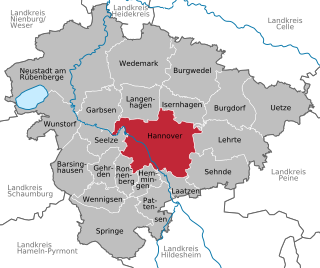 W
WBerlin is the capital and largest city of Germany by both area and population. Its 3.8 million inhabitants make it the European Union's most populous city, according to population within city limits. One of Germany's sixteen constituent states, Berlin is surrounded by the State of Brandenburg and contiguous with Potsdam, Brandenburg's capital. Berlin's urban area, which has a population of around 4.5 million, is the second most populous urban area in Germany after the Ruhr. The Berlin-Brandenburg capital region has over six million inhabitants and is Germany's third-largest metropolitan region after the Rhine-Ruhr and Rhine-Main regions.
 W
WBremen, officially the City Municipality of Bremen, is the capital of the German state Free Hanseatic City of Bremen, a two-city-state consisting of the cities of Bremen and Bremerhaven. With about 570,000 inhabitants, the Hanseatic city is the 11th largest city of Germany and the second largest city in Northern Germany after Hamburg.
 W
WDresden is the capital city of the German state of Saxony and its second most populous city, after Leipzig. It is the 12th most populous city of Germany, the fourth largest by area, and the third most populous city in the area of former East Germany, after Berlin and Leipzig. Dresden's urban area comprises the towns of Freital, Pirna, Radebeul, Meißen (Meissen), Coswig, Radeberg and Heidenau and has around 790,000 inhabitants. The Dresden metropolitan area has approximately 1.34 million inhabitants.
 W
WDüsseldorf is the capital city of North Rhine-Westphalia, the most populous state of Germany. It is the second-largest city in the state and the seventh-largest city in Germany, with a population of 617,280. Düsseldorf is classified as a GaWC Beta+ world city.
 W
WErfurt is the capital and largest city in the state of Thuringia, central Germany. It is located in the southern part of the Thuringian Basin, within the wide valley of the Gera river. It is located 100 km (62 mi) south-west of Leipzig, 300 km (186 mi) south-west of Berlin, 400 km (249 mi) north of Munich and 250 km (155 mi) north-east of Frankfurt. Together with a string of neighbouring cities Gotha, Weimar, Jena and others, Erfurt forms the central metropolitan corridor of Thuringia called Thüringer Städtekette with over 500,000 inhabitants.
 W
WHamburg, officially the Free and Hanseatic City of Hamburg, is the second-largest city in Germany after Berlin, as well as the overall 7th largest city and largest non-capital city in the European Union with a population of over 1.84 million. Hamburg's urban area has a population of around 2.5 million and its metropolitan area is home to more than five million people. The city lies on the River Elbe and two of its tributaries, the River Alster and the River Bille. One of Germany's 16 federated states, Hamburg is surrounded by Schleswig-Holstein to the north and Lower Saxony to the south.
 W
WHanover is the capital and largest city of the German state of Lower Saxony. Its 535,061 (2017) inhabitants make it the 13th-largest city in Germany as well as the third-largest city in Northern Germany after Hamburg and Bremen. Hanover's urban area comprises the towns of Garbsen, Langenhagen and Laatzen and has a population of about 791,000 (2018). The Hanover Region has approximately 1.16 million inhabitants (2019).
 W
WKiel is the capital and most populous city in the northern German state of Schleswig-Holstein, with a population of 249,023 (2016).
 W
WMagdeburg is the capital and second-largest city of the German state of Saxony-Anhalt, after Halle (Saale). It is situated on the Elbe River.
 W
WMainz is the capital and largest city of Rhineland-Palatinate, Germany.
 W
WMunich is the capital and most populous city of Bavaria. With a population of 1,558,395 inhabitants as of 31 July 2020, it is the third-largest city in Germany, after Berlin and Hamburg, and thus the largest which does not constitute its own state, as well as the 11th-largest city in the European Union. The city's metropolitan region is home to 6 million people.
 W
WPotsdam is the capital and largest city of the German state of Brandenburg. It directly borders the German capital, Berlin, and is part of the Berlin/Brandenburg Metropolitan Region. It is situated on the River Havel some 25 kilometres southwest of Berlin's city centre.
 W
WSaarbrücken is the capital and largest city of the state of Saarland, Germany. Saarbrücken is Saarland's administrative, commercial and cultural centre and is next to the French border.
 W
WSchwerin is the capital and second-largest city of the northeastern German state of Mecklenburg-Vorpommern as well as of the region of Mecklenburg, after Rostock. It has around 96,000 inhabitants, and is thus the least populous of all German state capitals.
 W
WStuttgart is the capital and largest city of the German state of Baden-Württemberg. It is located on the Neckar river in a fertile valley known locally as the "Stuttgart Cauldron" and lies an hour from the Swabian Jura and the Black Forest. Its area has a population of 635,911, making it the sixth largest city in Germany. 2.8 million people live in the city's administrative region and 5.3 million people in its metropolitan area, making it the fourth largest metropolitan area in Germany. The city and metropolitan area are consistently ranked among the top 20 European metropolitan areas by GDP; Mercer listed Stuttgart as 21st on its 2015 list of cities by quality of living, innovation agency 2thinknow ranked the city 24th globally out of 442 cities and the Globalization and World Cities Research Network ranked the city as a Beta-status global city in their 2014 survey. Stuttgart was one of the host cities for the official tournaments of the 1974 and 2006 FIFA World Cups.
 W
WWiesbaden is a city in central western Germany and the capital of the state of Hesse. As of June 2020, it had 290,955 inhabitants, plus approximately 19,000 United States citizens. The Wiesbaden urban area is home to approximately 560,000 people. Wiesbaden is the second-largest city in Hesse after Frankfurt am Main.